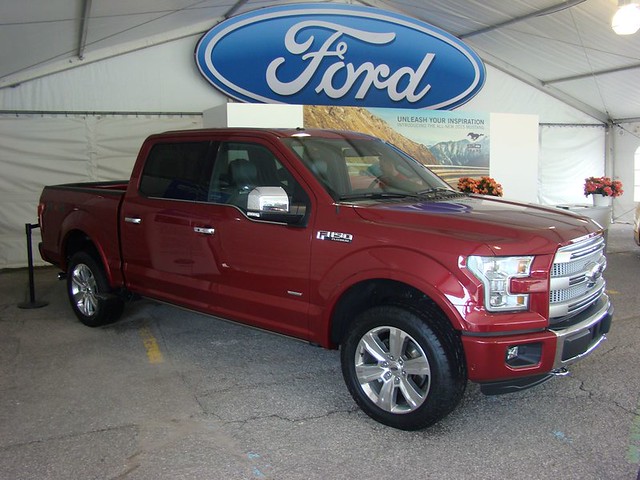Despite the changing automotive climate where electrified powertrains and crossover vehicles is part of a new 21st century normal, the traditional products remains the main driving force for North America. A vehicle type renowned for toughness and versatility for serving a wide industry, pickup trucks exist as the bread and butter of major automakers. When it was time for Ford to reengineer their market-topping F-150 truck for the 2015 model year, it was accepted as the blue oval’s most important unveiling. Accounting for more than 30 percent of the Ford Motor Company’s total vehicle sales in the United States, the F-Series line-up, that includes the general duty F-150 half-ton, plays a pivotal part in the business’ financial health. On Tuesday, the first 2015 F-150 pickup truck rolled off the assembly line at the Ford Rouge Center.
As the first 2015 Ford F-150 coasted along the production floor, the most radical redesign of the popular pickup truck transitioned from the showstopper of Detroit’s North American Auto Show to the vehicle tasked with helping people move miscellaneous loads. Exterior styling depicting a large front grille with available LED headlights as well as a bed incorporating BoxLink cargo management is only the tip of the anvil describing the new F-150. Engineers creating the new-generation Ford F-150 for 2015 placed intense focus into the materials used to shape their latest half-ton truck. Constructed on a high-strength steel frame, body panels made of military-grade aluminum introduces Ford truck buyers to something quite unique. Ford claims the use of more-advanced materials allows their new F-150 to weigh up to 700 pounds less.

While the aluminum construction had Ford requiring to extend additional training to employees at their customer service center body shops, the aluminum panels of the 2015 F-150 boast not only lighter weight compared to steel but promises long-term durability and heightened corrosion-resistance. While Ford’s use of aluminum is groundbreaking for an American-made pickup truck, the use of the lightweight material is not unprecedented in the grand scope of the utility vehicle world. The original Land Rover utility vehicles built in 1948 utilized aluminum bodywork partly due to the shortage of significant steel supplies in the United Kingdom following the Second World War.
In addition to the body and frame construction, the 2015 Ford F-150 including two engines using the auto company’s EcoBoost technology. The 365-horsepower, twin-turbocharged 3.5-liter V-6 is joined by a new 2.7-liter powerplant. Generating 325 horsepower, the 2.7-liter engine includes standard Auto Start-Stop technology. A naturally aspirated 3.5-liter V-6 and the top-of-the-line made in Canada 5.0-liter V-8 engine are also offered as powerplant choices with the 2015 model year Ford truck. With the 385-horsepower V-8, the F-150 delivers improved high-end towing capacity. Ford confidently asserts fuel economy of the full-sized truck will climb by at least five percent compared to the previous model.
With regular, SuperCab and SuperCrew cabin versions entering the marketplace, the 2015 Ford F-150 will also cater to the heightened demands of drivers as well as passengers. Multiple interior storage compartments, MyFord Touch with eight-inch touchscreen and a 360-degree camera view will be available inside the new truck.
Planning to build over 700,000 examples of the 2015 Ford F-150 in a full year, the Ford Rouge Center plant will not be the only place where the half-ton truck will be assembled. Early next year, production of the new F-150 is set to start at the Kansas City Assembly Plant. The United States and Canada will be one of 90 markets for the new Ford F-150.
Information and photo source: Chris Nagy, Ford Motor Company



Comments
Post a Comment